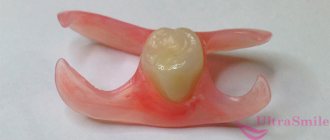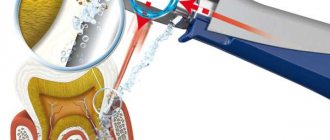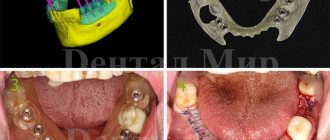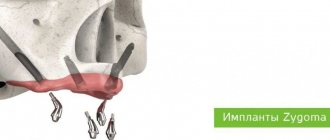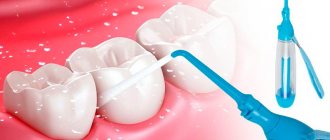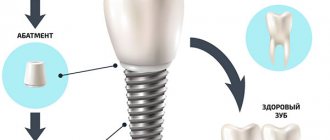Modern dentistry is undoubtedly the latest generation of implantation. Science and technology in this area are ahead of their time; the development of implantology can be compared to space developments. Continuous study of a huge number of clinical cases, analysis of results, implementation of innovative solutions, improvement of materials and types of implants has already made it so that modern dental implantation is completely painless, safe and allows you to restore an entire row of teeth even in one visit.
Modern dental implantation
Dental restoration using implants began in the mid-twentieth century. The metal rod installed in the jawbone has changed over time, and new methods of its installation have appeared. Outdated plate implants are no longer used. Doctors have moved away from the intramucosal, superiosteal method and some others. Nowadays, new generation dental implants are artificial roots made of titanium alloy, which are biocompatible with the human body, do not cause allergic reactions, are durable and reliable for chewing loads. They play the role of real roots, preventing the atrophy of bone tissue that would inevitably occur in the place of lost teeth. And new implantation protocols make it possible to quickly solve the problem of the absence of one or all teeth, without preparing healthy teeth and even avoiding sinus lifting and increasing the volume of bone tissue in case of its deficiency.
Dental restoration forever!
Installation of a two-stage implant ROOTT (Switzerland) - RUB 27,000. 32,000 rub.
FAQ
— A specialist at the clinic said that implantation is impossible due to periodontitis, what should I do?
Periodontitis is not an absolute contraindication to the installation of implants. Many specialists who lack the qualifications to solve problems with complex patients use this as an excuse for their reluctance to take responsibility. Periodontitis leads to bone tissue atrophy, so tooth mobility increases, and many of them must be removed altogether. This suggests that due to periodontitis, implantation remains the only method of stopping bone atrophy. Implants, unlike removable dentures, direct the load of chewing onto the bone.
— What complications can implantation cause?
Complications most often occur when large vessels or nerves are damaged during surgery. When working as a highly qualified specialist, the probability of such an outcome is close to zero. All the characteristics of the body, including the likelihood of it rejecting foreign bodies, are identified at the preparatory stage, and if there are factors prohibiting the operation, another method of tooth restoration is proposed.
Modern methods of dental implantation
The dental clinic can offer the patient atraumatic, fast and effective modern implantation methods.
Express implantation
(simultaneous implantation). The method of implanting a titanium pin directly into the socket of an extracted tooth is used. Advantages of the one-stage flapless method:
- there is no need to cut the tissue, suturing it, which means less time will be spent on healing and removal of sutures;
- the non-traumatic nature of the operation, which is morally easier for a person to bear;
- installation lasts up to 15 minutes.
In what cases is this transgingival method of modern dental implantation suitable:
- in the absence of one or all teeth on the upper or lower jaw;
- There is a time limit for recovery (it must be done urgently).
In addition, there should not be severe inflammation of the gums and insufficient bone tissue (consultation with a doctor is necessary to resolve these issues).
Implantation with immediate loading
(one-stage implantation). Just a couple of decades ago, after implantation, it was necessary to walk without a visible tooth, without a crown or prosthesis, for the entire period of osseointegration (3-6 months). Which, naturally, caused terrible psychological discomfort in any patient. The latest generation of implantations allows you to immediately install an adaptive prosthesis. A person leaving the dentist's office can smile, speak without defects and eat normally. During the entire period of engraftment of the titanium pin, its fusion with tissues and blood vessels, a lightweight temporary prosthesis allows you to get used to the presence of the orthopedic structure in the mouth and not experience discomfort in everyday life.
What type of implantation should I choose to restore my teeth?
Let’s be clear: the Internet will not give you an answer to this question. Because to correctly select an implantation technique, a thorough diagnosis is required, which will show the condition of the bone tissue, help to promptly identify contraindications, and select the right implants.
If you decide that you will restore your teeth with implantation, you need to make an appointment with a specialist - an implantologist. Competent and experienced implantologists from our dentistry in Moscow - Firadent - are ready to answer all your questions about implantation.
We offer our patients the most modern implantation techniques, implantation systems from the world's leading brands, technologies that allow you to plan implantation and 100% predict its result! Implantation in our clinic is a guaranteed high-quality and durable result, treatment without pain and in comfortable conditions!
Indications:
- absence of one, several teeth or complete edentia.
Dental implantation using a surgical template
. The use of 3D modeling helps the doctor accurately plan the operation, eliminating all risks and undesirable consequences. The modern method of implantation using a surgical template is the key to the successful work of an implantologist and orthopedist.
After a CT (computed tomography) scan, the doctor outlines the location of the implants in the program, which he then works with to decide at what angle and what type of implant to install. And the technician is already preparing to make temporary crowns and prostheses, which will be fixed on the day of implantation.
3D implantation using a surgical guide
Computer technology for installing dental implants is based on the use of special programs for virtual modeling of this process. When planning implantation, the following are taken into account:
- all the nuances of the anatomical structure of the patient’s jaws;
- location of blood vessels and nerves in the area of future installation of rods;
- proximity of the walls and bottom of the nasal sinuses to the site of implant immersion.
Based on the data obtained as a result of high-precision planning, a surgical template is produced. It has special holes for drilling the bone - in the exact place, at the desired angle. This template eliminates the risk of error when installing the implant. And it makes it possible to use this method of treatment even if the patient has a lack of bone tissue.
Indications:
- absence of several teeth or complete edentia;
- a complex clinical case that requires a particularly careful approach.
Implantation
All-on-4 and All-on-6
. Modern dental implantation “All on four” or “All on six” allows you to reduce the financial burden of restoring the entire dentition. By implanting only 4 or 6 titanium rods, you can install a complete denture on the jaw with 10-12 artificial crowns. Installing an implant instead of each tooth would require more money and time.
What anesthesia is used for All-on-6 implantation
For implantation of “all on 6” we use local anesthesia, but if the patient has any problems with blood pressure, the patient is very afraid, he has a fear of dental interventions, or the person simply does not want to somehow be present at the operation at this time , in such cases we offer patients sedation.
With sedation, when the patient comes (for surgery), he falls into a medicated sleep, and for him time passes very quickly. Many patients say: “It feels like I just closed my eyes a little, fell asleep and you woke me up - time flew by.” The operation itself takes about 2.5 hours.
Implant rejection due to peri-implantitis
Why might implant failure occur? Peri-implantitis can develop both with “all-on-6” implantation and with a single design. We have a lot of experience using the “all on 6” method, I can’t even say the exact number, because a lot of operations have been performed. And the only thing I can say is that in all time only 1 time
(!!) we lost the implant in the patient’s distal region.
The patient was 78 years old and she was a doctor herself. The loss of the implant was associated with overload specifically in the distal region. She had “everything done to 6” on the upper and lower jaw. And she says: “After 10-15 days, I forgot that the teeth in my mouth were on implants and began to use them in full.” There was an overload on the lower right side and the implant was lost. We reinstalled her implant. Since the structure that was fixed in the mouth is still a temporary structure, not permanent, we reinstalled the implant. And then the rehabilitation proceeded as normal. This was the only case when the implant was lost under an “all-to-6” load.
The patient was happy that despite the fact that he himself was partly to blame, the patient could say: “I didn’t do anything at all and neither did he.” But the patient was adequate, she admitted: “yes, she says, I already forgot about the implant, I felt comfortable.” She was pleased that everything was done under warranty and there were no additional financial burdens on her.
Indications:
- absence of most teeth or complete edentia;
- inability to wear a removable lamellar denture.
This modern implantation method allows people with removable dentures to securely fix it.
Complex implantation
. “All inclusive” in dental treatment. In one visit to the dentist, teeth are removed (if necessary) and an implant is inserted. A method for immediately restoring multiple teeth. Prosthetics on 6-12 implants with a fixed prosthesis.
Indications:
- impossibility of two-stage implantation;
- absence of 3 teeth to complete absence;
- urgency of recovery.
Resmile
. Implantation technology without cuts or sutures. The transgingival method of implanting a titanium root is atraumatic, healing occurs quickly. The combination of implants from one system increases the success rate and minimizes complications. This is facilitated by a titanium-based ceramic composite prosthesis, which is installed on the 4th day and does not require replacement subsequently; it is permanent.
Laser implantation
This method of installing a root substitute cannot be classified as a new dental implantation technology. But the use of a laser helped eliminate some of the disadvantages of the classical technique, since in this case a source of optical radiation is used instead of a scalpel. The laser method makes it possible to install implants without peeling off flaps; only small incisions are made on the mucous membrane. The laser is also used to treat bone tissue.
Advantages of laser implantation:
- The tissues of the oral cavity do not directly come into contact with the instrument when cutting mucous membranes.
- Sutures are not required after the intervention, since the installation is low-traumatic.
- The damaged edges of the mucous membranes are immediately sealed, so there is no bleeding.
- The laser provides additional bactericidal treatment.
- Scars are not formed after the operation.
- The risk of developing inflammation and other complications is minimized.
- The recovery period after surgery is faster than with installation using a scalpel.
New generation of dental implants
Implant manufacturers are constantly researching and developing new types of dental implants. By studying numerous clinical pictures from the practice of doctors, they create new types of threads, improve the alloy, and change the method of processing the surface of the product.
New generation dental implants:
- Compression implants. The very tight contact of titanium and tissue promotes rapid osseointegration.
- Multi-units with a rotating abutment head, screw fastening for fixing the prosthesis with screw fixation.
- Basal implants are placed where there is critically little bone tissue. Their implantation occurs in deeper, dense layers.
The titanium alloy is being improved, and the grinding and processing of the implant surface takes place in several stages. This is sandblasting and etching. The main thing is to achieve the necessary roughness of the root part of the implant for successful survival and cleanliness, the absence of traces of organic matter during production. The necks are made smooth to prevent the accumulation and reproduction of bacteria on them. Every nuance is taken into account. And the creation of a wide range of implants allows the doctor to comprehensively use different types of artificial roots within one operation.
Modern systems have a warranty of 25-50 years, and many manufacturers provide a lifetime warranty. The survival rate of implants takes from three months to six months, and the success of osseointegration of new generation dental implants reaches 98.5%.
Alternative Methods
You can restore the integrity of the dentition using:
- removable prosthetics. It is inexpensive and can immediately replace all lost teeth. But it takes a long time to get used to such voluminous structures; at first they can cause a gag reflex. For more reliable fixation, additional means such as Corega are often used to prevent the prosthesis from accidentally falling out. Aesthetics are poor, and tissue atrophy progresses inexorably. With prosthetics on implants this is impossible.
- prosthetics with a bridge supported by adjacent teeth. In this case, the supporting teeth grind down and become weaker. With constant chewing load, such structures may collapse over time.
- crowns If the tooth root is preserved, it can be restored with a crown. If the root is destroyed, then the only options left are single implantation or a bridge;
- classical implantation. A two-stage protocol involves installing a root-shaped implant, waiting for it to engraft into the bone, and only then fixing the permanent prosthesis. This is a long process (from 3 to 6 months), during which the titanium rod is completely osseointegrated into the jaw bone.
Stages of each method
Prosthetics on implants, the main techniques of which we will consider below, is a certain sequence of actions by a specialist.
Depending on the chosen method, they may differ, and different implant systems will be involved in the work. "All-on-4"
The installation process involves working with four implants that can withstand the load immediately after implantation. Immediately after the installation of the implants, a temporary acrylic prosthesis is often installed. Depending on desire and capabilities, the patient can choose metal-ceramics or zirconium dioxide for prosthetics after complete osseointegration.
Preparatory stage. A complete diagnosis of the oral cavity in order to identify contraindications is mandatory before starting treatment. This stage also includes modeling the jaw and agreeing on a treatment plan with the patient.
Installation of implants. Two implants are implanted in the front, and the remaining two are placed on the sides at an angle of 45 degrees. Only lightweight, heavy-duty materials are used.
Installation of prostheses. Prostheses made from an impression are fixed with screws or special cement.
"All-on-6"
Acrylic is most often used as a temporary prosthesis. After osseointegration, the patient can choose zirconia or metal ceramics.
Preparation. Expert consultation, 3D tomography, drawing up and approval of a treatment plan.
Surgical stage. The doctor will make small incisions in the gums and prepare a place for the implants, which he will then install. The final step will be suturing.
Orthopedic stage. A few hours after implantation, a temporary permanent acrylic prosthesis can be installed on them.
Trefoil
A ready-made titanium beam structure is used, which takes into account the anatomical features of the alveolar ridge of the lower jaw. Acrylic, metal ceramics or zirconium dioxide are available to the patient to choose from after implantation.
Preparatory stage. Computer diagnostics and testing. It is necessary to obtain accurate data, so the doctor measures the vertical distance of occlusion and the relationship of the jaws in the articulator.
Surgical stage. The alveolar ridge is shortened, a bone platform is formed and implants are installed. Then the abutments are splinted and fixed, taking into account possible deviations from the optimal location.
Dental stage. The specialist creates a master model with which you can configure and adjust the mechanism that fixes the tire. An impression is taken and bite parameters are recorded. After manufacturing, the prosthesis is fixed in the oral cavity.
Crowns
Installing crowns on an implant can take up to six months or even a whole year if the patient has severe bone tissue atrophy, i.e. the teeth were lost a long time ago.
Preparatory stage. The doctor will identify contraindications and examine the bone tissue.
Sinus lift. Bone tissue augmentation can be carried out simultaneously with implantation, or separately. In some cases, this process extends treatment by several months.
Installation of implants. Depending on the chosen method, the structure is installed in the oral cavity - in a conventional or lightweight way. The choice depends on the thickness of the bone tissue.
Osseointegration. Engraftment of the structure takes approximately 4-6 months. The exact period depends on the individual characteristics of the patient’s bone tissue and its ability to regenerate.
Prosthetics. When the implants have completely taken root, the doctor makes an impression of the oral cavity using impression material. Also, for the manufacture of zirconium crowns, a special scanner is used, which will help you select the exact shade of the crowns. Finished crowns are installed and secured using dental cement or screw fixation.
Bridges
The bridge can be made of metal, metal-ceramic or zirconium dioxide. Its installation on implants consists of completing the following sequence of actions:
Preparation. The doctor identifies the presence of contraindications and examines the bone tissue in detail. If necessary, the patient can be prescribed a sinus lift, which will increase the treatment period.
Implantation. The number of implants depends on the size of the prosthesis. Typically it varies from two to four. After installation of the structure, a period of osseointegration follows.
Installation of abutments and taking impressions. After healing, abutments are installed on the implants and an impression of the jaw is taken. The production of the bridge begins.
Prosthetics. The dental bridge is fixed to the abutments using dental cement.
Price
Modern dental implantation is more expensive than prosthetics. The cost of treatment depends on several factors:
- chosen method;
- use of a surgical template;
- number of implants;
- company manufacturer;
- material of prosthesis, crown;
- qualification of an implantologist.
For example, the price of one-stage implantation with a temporary crown is about 40,000 rubles, the All-on-4 technology of one jaw with an adaptive prosthesis will cost from 190,000 rubles, one-stage implantation with complete edentia of one jaw on 6 compression implants and a temporary prosthesis - in the region RUB 265,000 The cost item may increase due to additional diagnostics and prosthetic materials.
Where to go for the latest generation of dental implants
Only dental clinics with technologically advanced diagnostic and surgical equipment and highly qualified staff can offer a choice of modern methods of dental implantation and a guarantee for their work.
The table shows several Moscow clinics where you can restore a beautiful smile in an advanced way. We advise you to find out the cost and current promotions directly on their websites.
| dental clinic | Website |
| Center for Dental Implantology ROOTT (RUTT) | https://dentalroott.ru |
| Dentum dentistry | https://dentumclinic.ru |
| City-Dent | https://city-dent.rf |
| The president | https://www.prezi-dent.ru |
| Center Family Dentistry | https://family-dental.ru |
